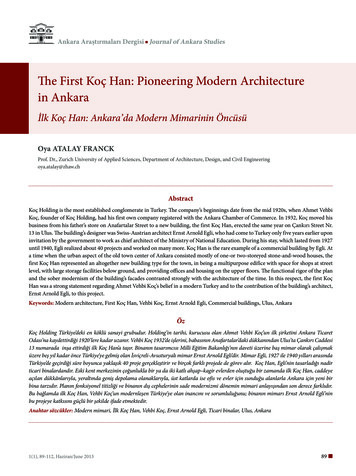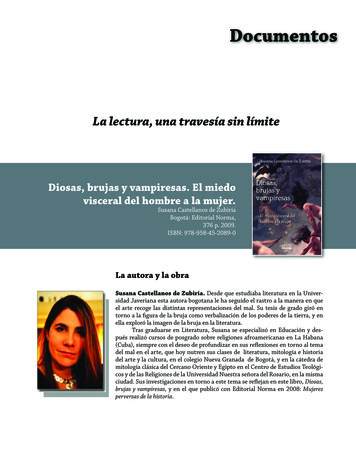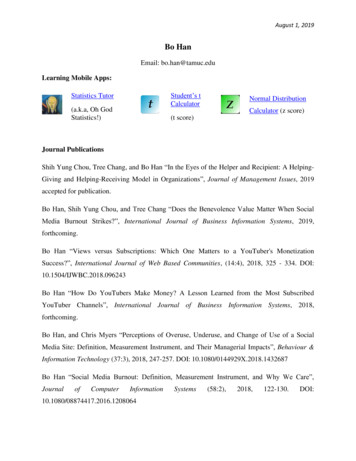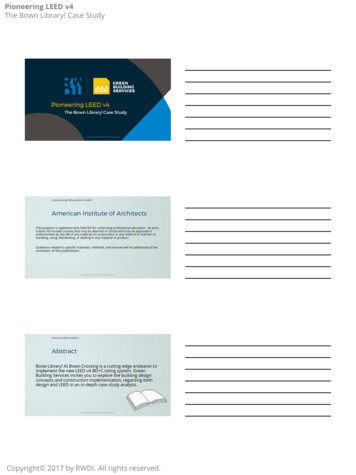
Transcription
Ankara Araştırmaları Dergisi n Journal of Ankara StudiesThe First Koç Han: Pioneering Modern Architecturein Ankaraİlk Koç Han: Ankara’da Modern Mimarinin ÖncüsüOya ATALAY FRANCKProf. Dr., Zurich University of Applied Sciences, Department of Architecture, Design, and Civil Engineeringoya.atalay@zhaw.chAbstractKoç Holding is the most established conglomerate in Turkey. The company’s beginnings date from the mid 1920s, when Ahmet VehbiKoç, founder of Koç Holding, had his first own company registered with the Ankara Chamber of Commerce. In 1932, Koç moved hisbusiness from his father’s store on Anafartalar Street to a new building, the first Koç Han, erected the same year on Çankırı Street Nr.13 in Ulus. The building’s designer was Swiss-Austrian architect Ernst Arnold Egli, who had come to Turkey only five years earlier uponinvitation by the government to work as chief architect of the Ministry of National Education. During his stay, which lasted from 1927until 1940, Egli realized about 40 projects and worked on many more. Koç Han is the rare example of a commercial building by Egli. Ata time when the urban aspect of the old town center of Ankara consisted mostly of one-or two-storeyed stone-and-wood houses, thefirst Koç Han represented an altogether new building type for the town, in being a multipurpose edifice with space for shops at streetlevel, with large storage facilities below ground, and providing offices and housing on the upper floors. The functional rigor of the planand the sober modernism of the building’s facades contrasted strongly with the architecture of the time. In this respect, the first KoçHan was a strong statement regarding Ahmet Vehbi Koç’s belief in a modern Turkey and to the contribution of the building’s architect,Ernst Arnold Egli, to this project.Keywords: Modern architecture, First Koç Han, Vehbi Koç, Ernst Arnold Egli, Commercial buildings, Ulus, AnkaraÖzKoç Holding Türkiye’deki en köklü sanayi grubudur. Holding’in tarihi, kurucusu olan Ahmet Vehbi Koç’un ilk şirketini Ankara TicaretOdası’na kaydettirdiği 1920’lere kadar uzanır. Vehbi Koç 1932’de işlerini, babasının Anafartalar’daki dükkanından Ulus’ta Çankırı Caddesi13 numarada inşa ettirdiği ilk Koç Han’a taşır. Binanın tasarımcısı Milli Eğitim Bakanlığı’nın daveti üzerine baş mimar olarak çalışmaküzere beş yıl kadar önce Türkiye’ye gelmiş olan İsviçreli-Avusturyalı mimar Ernst Arnold Egli’dir. Mimar Egli, 1927 ile 1940 yılları arasındaTürkiye’de geçirdiği süre boyunca yaklaşık 40 proje gerçekleştirir ve birçok farklı projede de görev alır. Koç Han, Egli’nin tasarladığı nadirticari binalardandır. Eski kent merkezinin çoğunlukla bir ya da iki katlı ahşap–kagir evlerden oluştuğu bir zamanda ilk Koç Han, caddeyeaçılan dükkânlarıyla, yeraltında geniş depolama olanaklarıyla, üst katlarda ise ofis ve evler için sunduğu alanlarla Ankara için yeni birbina tarzıdır. Planın fonksiyonel titizliği ve binanın dış cephelerinin sade modernizmi dönemin mimari anlayışından son derece farklıdır.Bu bağlamda ilk Koç Han, Vehbi Koç’un modernleşen Türkiye’ye olan inancını ve sorumluluğunu; binanın mimarı Ernst Arnold Egli’ninbu projeye katkısını güçlü bir şekilde ifade etmektedir.Anahtar sözcükler: Modern mimari, İlk Koç Han, Vehbi Koç, Ernst Arnold Egli, Ticari binalar, Ulus, Ankara1(1), 89-112, Haziran/June 201389 n
O. Atalay Franck, The First Koç Han: Pioneering Modern Architecture in AnkaraIntroductionWhoever walks past Çankırı Street Nr. 13 in Ulus, Ankara,will probably not notice the building itself. The gaze mayrather be drawn to the opposite side of the street and ofUlus Square, to the highly ornamented Neo-Renaissanceİş Bankası building and the equally impressive, monumentally modernist Sümerbank General Directorate. What thisperson may not know is that the building on Çankırı StreetNr. 13 was actually built around the same time as the twobank buildings across the square, which were erected in1929 and 19381 (Figure 1).As a matter of fact, Çankırı Street Nr. 13 is one of the firstmodern office buildings in downtown Ankara and as sucha milestone in modern Turkish architecture. Its construction connects two personalities who shaped the early Turkish Republic each in his own way.One was Ahmet Vehbi Koç (Figure 2), entrepreneur andfounder of what today is Turkey’s largest industrial conglomerate. The other was Ernst Arnold Egli, born in Austria, architect, designer of numerous public buildings of theearly Republic and teacher of the first generation of modernTurkish architects. Not much is known about the buildingitself and the circumstances of its formation. Neither thearchitect nor his client mention it more than fleetingly intheir reminiscences. “I decided to open a department storeat Ulus Square in Ankara, opposite the present İş Bankasıbuilding. The space was then occupied by an old officebuilding. It was like the old hans of Ankara; shops facedthe street, but it had an inner courtyard. Professor Egli ofVienna, an architect, was in Turkey at the invitation of theMinister of Education. I had plans drawn up by him andconstructed a building that was considered very moderncompared with the Ankara buildings of that day,” VehbiKoç recollects in his memoirs (Koç, 1983, p. 56). Egli himself mentions this commission even more fleetingly, onlyreferring to having designed “three business/apartmenthouses in Ankara” in the early 1930s (Egli, 1969, p. 65).Vehbi Koç was born in Ankara in 1901 to an old Ankarafamily. His grandfather was a well-off official of the Ottoman government who also traded in wheat; his father,medrese-educated, eventually followed the grandfatherby entering the wheat-trade business (Koç, 1983, pp.11-12). From the very young age of 16, Koçzade AhmetVehbi was working as a merchant and entrepreneur, continuously looking for new business opportunities. In thefirst ten years of his professional career, his activities weremostly tied to his father’s. In 1926, he took over his father’sFigure 1. View ofÇankırı Street fromUlus Square in the2013 Koç Han is thethird building to left, İşBankası and Sümerbankcenter and right.Source: Photograph ofFadime Küçükhüseyin.n 90Ankara Araştırmaları Dergisi 2013, 1(1), 89-112
O. Atalay Franck, The First Koç Han: Pioneering Modern Architecture in Ankaraunprecedented changes were about to come, turning thequiet and dusty market town into an administration andservices center for the entire nation, with an urban population reaching well into the millions in only 80 years.Vehbi Koç certainly had the business instinct and sensesto seize the opportunities that arose from this particularincidence. In the mid and late 1920s, he tried his handoften simultaneously in a variety of trades, i.e. grain, building supplies, as well as textiles and leather. After a while,he opened a hardware store which he enlarged to includetextile supplies, glassware and others. Later on, Koç alsomanaged to become the Ankara representative of a wellknown department store–from which he bought goods–inİstanbul, which sold fridges, radios and other branded consumer goods. In 1928 he took on the Turkish distributorship for Standard Oil Company, the huge American petroleum company founded in 1870 by John D. Rockefeller.Figure 2. Vehbi Koç in his office at Koç Han, 1939, May 1.Source: Photograph of Vehbi Koç, 1939.business which became registered as “Koçzade AhmetVehbi” at the Ankara Chamber of Commerce. From thatfirst moment of entrepreneurial independence on, andthrough his entire life, Koç ventured into a large varietyof trades, often working in cooperation with large European and American companies, as sales representative andagent, then as licensed manufacturer of foreign products.In 1963, his industrial companies such as Arçelik (kitchenand household appliances), Turkish Iron Casting FoundryInc. (Türk Demir Döküm Fabrikası) and Otosan (automobiles) were grouped under the common roof of Koç Holding Durable Consumer Goods Group. In 1984, Koç withdrew from business life and dedicated himself primarily tohis philanthropical work. He died in 1996 in Antalya.From the 1920s onward, building activities in Ankarasoared up. The construction boom triggered by the relocation of the capital from İstanbul to Ankara not onlyrequired petroleum and gasoline for driving trucks andengines, but also building materials in enormous quantities. It also provided for many commissions to architectsand builders. For a farsighted and talented entrepreneur asVehbi Koç this was an excellent context in which to enternew areas of business. With the enormous requirementsregarding the construction of the new capital-ministriesand schools, universities and hospitals, train stations andeven air fields had to be built, and of course housing forthe many people who came to Ankara to work for the government–there was a plethora of opportunities. To expandhis business into construction materials and then into contractor work for the government seemed a sensible decision at the time.In the late 1910s and early 1920s, when Koç started to tradewith goods from the Ottoman capital İstanbul, Ankara wasa provincial Anatolian town with a population approximately 20.000-25.000. Its history, however, goes back tothe Roman Empire and even to the times of the Phrygianculture in the 7th and 8th century BC. In that period, Ankarawas an important center on the “Royal Road” built by Persian king Darius which connected the Aegean coast andBabylon and continued further east towards central Asia.In fact, trade always played an important role in the city’shistory and caused many ups and downs in its development. With its new role as the Republic’s capital, however,In fact, in 1932, Vehbi Koç received a major governmentalcontract when he was assigned the electrical installationsand elevators of Numune Hospital, the new state hospitalof Ankara. This commission did not just fall into his lap,though. In his memoirs, Koç recalls that it was very difficultto convince Refik Saydam, Minister of Health at that time,that a Turkish firm would be capable of handling such ajob. The minister demanded that Koç, as a measure of quality assurance, had to provide for a foreign business partnerin order to win the tender for building hospital. “Turkscannot manage to do this job. I shall give you the contractonly if you prove you have a foreign partner,” Vehbi KoçAnkara Araştırmaları Dergisi 2013, 1(1), 89-11291 n
O. Atalay Franck, The First Koç Han: Pioneering Modern Architecture in AnkaraJansen, Theodor Jost, Robert Oerley, Hanz Poelzig, ErnstReuter, Wilhelm Schütte, Margarete Schütte-Lihotzky,Bruno Taut, Robert Vorhoelzer and Martin Wagner (Atalay Franck, 2011, p. 45).For Koç, his venture into the contracting business whenhe was only around thirty years of age was certainly notrisk-free. Although the Numune project would lead toother contracting commissions–from other state hospitalsto parts of the national railroad–Koç was not happy withthe way these commissions were handed out by the government. The assignments were based on a bidding systemthat would always prefer the lowest bidder. This had consequences both for the clients and the contractors alike, inthat the contractors had to cut many corners regarding thequality of the construction in order to make a profit fromtheir commissions. According to his testimonies, this wasone of the reasons why Koç shifted his business intereststo other areas of commerce and industry, where his goodsense of business made him see better potentials.Figure 3. Ernst Egli in Vienna, circa 1927.Source: Photograph of Ernst Egli, ca. 1927.remembers Saydam saying. Koç managed to find a partnerfirm in Germany (Koç, 1983, pp. 45, 52).The notion that Turkish planners and builders were not upto the task of establishing the infrastructure for the Republic and its capital was widespread in government circlesin the 1920s and early 1930s. Especially in the key positions–chief architects of ministries, urban planners, headofficials of the city’s building authorities–the governmentrelayed almost entirely on foreign experts to establish theState’s infrastructure. Between 1924 and 1942, there werealmost 40 architects and urban planners from various Central European countries–and many other foreign experts–employed by the city and state government. Among thesewere Paul Bonatz, Carl C. Lörcher, Ernst Egli, MartinElsässer, Franz Hillinger, Clemens Holzmeister, Hermannn 92It is a mark of Koç’s independence as an entrepreneur whenhe decided to build a new center for his business activities.The plans to build Koç Han links Koç–for a brief momentin time–Koç to the foreigner Ernst Egli, the architect of theHan. Egli was born in 1893 in Vienna, son of a Swiss fatherand a Slovakian mother (Figure 3). He came to Turkey in1927, at only 34 years of age, upon invitation by the government to work as chief architect of the Ministry of NationalEducation. He had been recommended for this task byClemens Holzmeister, a well-known Austrian architect andprofessor of architecture at the Vienna School of Fine Arts,where Egli was his assistant. The invitation had originallygone to Holzmeister himself, but Holzmeister claimed tobe too busy with other endeavours, proposing his assistantinstead (Egli, 1969, p. 41).Egli was appointed as the architect-in-chief for the Ministryof National Education (Maarif Vekâleti). Almost simultaneously, he was commissioned with the reformation andmodernization of architectural education at the Academyof Fine Arts in İstanbul, nowadays Mimar Sinan Fine ArtsUniversity. After a preparatory period of two years, Egli wasappointed dean of the School of Architecture at the Academy, a post he held until 1936 when he resigned from bothposts mainly because of budget disputes (Egli, 1969, p. 75;Nicolai, 1998, p. 39). After his resignation, Egli receivedonly few new commissions as an architect. In 1940, hedecided to move to Switzerland, home country of his fatherAnkara Araştırmaları Dergisi 2013, 1(1), 89-112
O. Atalay Franck, The First Koç Han: Pioneering Modern Architecture in Ankarabut a foreign land to him. Already during his stay in Turkey,Egli devoted a part of his efforts to questions of urbanismand city planning, working on a number of master plansfor Turkish cities such as Edirne and Samsun. In Switzerland, his professional focus shifted entirely from architecture to urban planning. From 1942 to 1963 Egli taught atthe Swiss Federal Institute of Technology (ETH) in Zurich,first as senior lecturer for the history of urbanism, then asprofessor for urbanism. Egli was also co-founder of theETH’s Institute for Town, Regional, and National Planning.Between 1948 and 1950, Egli worked as a United Nations(UN) expert and city planner in the Middle East. From 1953to 1955, Egli returned to Turkey to teach city and regionalplanning at the School of Political Sciences of Ankara University (Mekteb-i Mülkiye, today Siyasal Bilgiler Fakültesi).He died in 1973 in Meilen near Zurich.The CommissionEgli’s influence on Turkish architecture in the 1930s emanated as much from his work as a teacher as from hisdesigns for public and private clients: mostly the Ministryof National Education and the Turkish Aeronautical Association (Türk Hava Kurumu), but also wealthy officials andindustrials. His influence was thus twofold: through hisexemplary work as an architect and through his work as ateacher, educating the first generation of modern architectsin Turkey. In this, Egli also played a role in the advancement of the national project for the modernization andwesternization of the country. Like modern clothing andthe Latin alphabet, modern architecture was part of therepertoire of the state for the promotion of the new order.It was believed that modernism as one of the underlyingprinciples of the new nation would only establish itself insociety if it would show in–and give form to–every important aspect of public life, including architecture (Bozdoğan,2001, pp. 62-80).In the 13 years of his stay in Turkey, Egli realized about40 projects, many of which take an important place in thecanon of early Turkish modernism. Among these are: StateConservatory of Music (Devlet Konservatuvarı) (19271928), Turkish Court of Accounts (Sayıştay) (1928), İsmetPaşa Girls’ Institute (İsmet Paşa Kız Enstitüsü) (1930-1934),Higher Agricultural Institute (Yüksek Ziraat Enstitüsü)(1930-1933), administration building of the Turkish Aeronautical Association (1933-1934), school building of theTurkish Aeronautical Association (1936-1938), AnkaraUniversity School of Political Sciences (1935-1936), VillaAnkara Araştırmaları Dergisi 2013, 1(1), 89-112Ragıp Devres (1931-1932), Villa Fuat Bulca (1934-1936),Embassy Buildings for Switzerland and Iraq (1936-1938)(Atalay Franck, 2012, pp. 244-245).As a foreigner and high-ranking official, Egli was frequentlyinterviewed by journalists and quoted in the newspaperson various matters regarding the modernization project(Egli, 1969, p. 69). It may have been through this that VehbiKoç got to know Ernst Egli, or through his own governmental contacts. He may also have witnessed the construction of Egli’s first major statement as an architect in Turkey,the conversion and enlargement of the headquarters of theCourt of Accounts on İstasyon Street, just around the corner from Koç’s building lot on Hâkimiyet-i Milliye Square.In his memoirs Vehbi Koç describes how he decided, in1931, to build a business office for his growing enterprise.Around that time he had travelled to Europe2 where hewas impressed by huge department stores, especially theGalleries Lafayette in Paris and the Kaufhaus Wertheim inBerlin,3 which obviously stimulated his trader’s spirit.I was greatly impressed by the splendid departmentstores in the cities we visited. The ‘Galléries Lafayatte’attracted my attention. What impressed me most however, was the ‘Wertheim’ in Berlin, which stocked everyconceivable item. I went to this store perhaps ten times,and measured it; it was 245 metres in length. I said tomyself that they were human beings, like us, and if theycould do it, so could we, even if on a smaller scale (Koç,1983, p. 56).The idea for Koç Han may have emerged from theseimpressions. But Koç Han was no department store; it wasmuch smaller than those grandiose palaces of commerce inBerlin and Paris which had impressed Koç so much, and itwas an altogether different type of building, a multipurposeedifice whose structure reflected the smartness and versatility of its owner (Figure 4). The building was to providespace for shops at street level, with large storage facilitiesbelow ground. On the upper levels, the floor plans allowedfor various uses, especially housing and office, dependingon the owner’s own demands or on the demands of otherpeople and companies to whom Koç would let room. Thisversatility shows Koç’s business understanding in that heobviously wanted to have all options at hand to make surethe building would not lie waste, but produce income as allhis other business endeavours. Koç Han was a “ticarethane”of a new, modern kind, a “maison de commerce,” as it wasreferred to on Koç’s stationery at that time. Occasionally,93 n
O. Atalay Franck, The First Koç Han: Pioneering Modern Architecture in AnkaraArchitecture had a particular role in the process of nationbuilding. Modern architecture in Turkey in the 1920s and1930s is different from western modern architecture notonly in its formation, but also in its development program.After World War I and the War of Independence, Turkeywas economically grounded and torn by factional strife.As Afife Batur points out, the priorities of the new government had to be quite necessarily on the reconstruction ofthe infrastructure, the roads and railways, the war-ravagedcities of Western Anatolia, and the organization of the capital. For a few years, almost the entire output of the construction industry was dedicated to the public sector and–to a much lesser degree–to housing (Batur, 1984, p. 74).Figure 4. Koç Han.Source: Photograph of Koç Han, n.d.it was also called “Koç Apartmanı.” On Egli’s drawingsand plans, the building was referred to as “Koçzade HanıProjesi” (Project of Koçzade Hanı).European and Turkish ContextIn Europe, the 1920s were a period characterized by a number of developments, some contradictory to each other. Thedecade was marked by democratic emancipation countered by the rise of fascism, technological progress, globaleconomic turmoil resulting twice in truly ruinous inflationin many countries but especially devastating in Germany,and an unprecedented and radical development in art andarchitecture (Haubrich, Hoffmann and Meuser, 2011, p.112). Turkey was in many ways less affected by these economic, social, and cultural turbulences. After the fall of theOttoman Empire and the War of Independence, it was lesstied into the financial and trade currents linking the economies of the western nations, and it was socially focussedinward to the project of building the new, modern nation.n 94Like modern clothing and the Latin alphabet, modernarchitecture was part of the repertoire of state propagandafor the new order. It was believed that modernism as oneof the underlying principles of the new nation would onlyestablish itself in society if it would show in–and give formto–every important aspect of public life. Architecture wasto provide the stage for modern society and republicanauthority. It was to be progressive and dynamic as well asfunctional. But simply copying foreign styles would not do,for the underlying principles of modernity could not beunderstood–and disseminated amongst the new generation–in such a way. Foreign experts were to show the paththrough the exemplary quality of their work and throughtheir teaching (Atalay Franck, 2012, pp. 31-36).These were the expectations Ernst Egli was confrontedwith when he came to Turkey in 1927. It was his task togive a distinctive modern shape to the buildings financedby the Ministry of National Education, the university institutes, the lyceums and schools. Like the overall programof “Westernization” and “Nationalization,” the demandsregarding the new architecture were in themselves contradictory. Nationalism was a key aspect of Kemalist reform;it was central to the modern Turkish society. The westernworld–which was perceived as superior economically,technically, socially and culturally–was considered exemplary to all aspects of the public and private domain. It wasto be at the same time “western” in appearance and providefor a clearly “national” identity, different from the West,distinctive of the Turkish Nation.The lack of domestic expertise for the project of modernization was one of the “structural dilemmas” of the newstate: Its Ottoman élite was discredited, because affiliatedwith the defeated regime of the past, or simply not knowlAnkara Araştırmaları Dergisi 2013, 1(1), 89-112
O. Atalay Franck, The First Koç Han: Pioneering Modern Architecture in Ankaraedgeable, and the next–modern–generation of bureaucrats, engineers, economist, and architects was not yeteducated. The task of giving the nation its new face had tobe entrusted to foreign experts4 (Batur, 1984, p. 76).Client and AgentThe Koç Han project had different meanings for Koç andfor Egli: For Vehbi Koç, it was a further step as a businessman to have a “company headquarters” which was morethan just a shop. It was also important to move from theback streets of Ulus district to the top business addressof Ankara in the 1930s, for what was Hakimiyet-i MilliyeSquare and is now called Ulus Square was not only the primary trade and banking spot of Ankara at that time–withİş Bankası and Ziraat Bankası5 on or near Hakimiyet-i Milliye Square and soon afterwards Sümerbank headquarters,replacing the Taşhan building (Figure 5). It was also whereİstasyon Street, today’s Cumhuriyet Street, began whichlinked downtown Ulus to the new main train station andalong which a number of key buildings of the early yearsof the Republic were located, the first parliament, AnkaraPalace Hotel (Ankara Palas Oteli)6 by architects Vedat Tekand Kemalettin Bey, and the Court of Accounts designedby Ernst Egli (Figure 6). And it was the starting point ofAtatürk Boulevard, the new main North-South axis of thecity.For Koç, commissioning Egli with this project was probably a matter of considerable prestige. Egli was one of thehighly respected foreign expert in top ranks of the stateadministration. He was young, like Koç himself, both representing the new generation. And Egli had access to theinner circles of the government, even to the president ofthe Republic himself, Mustafa Kemal. For Vehbi Koç, theproject was proof of his belief in the new creed of Turkish society. He as a citizen and businessman worked handin hand with the government in establishing Turkey as aprogressive, modern, and civilized nation. Free trade andenterprising spirit were also marks of the new Turkey.Like his business endeavours, the modern architecture ofhis company office showed Koç as a believer in a futurewhich was promising to hard-working and open-mindedentrepreneurial people who had a feeling for the social andpolitical agenda of the country under Atatürk. Koç obviously saw the future in the West and in Western goods andlifestyle. He recalls how he studied intensively the management of the great, long-standing companies of Europeand America, such as Siemens, Ford, and General Electricin order to gain knowledge for his own business activities(Koç, 1983, pp. 98-101).Finally, the project may have served as a reference to Koç’sclaims as a builder, a “show piece”. Koç showed-on a smallscale-that he was able to build in the “modern style” and withmodern materials, especially reinforced concrete (Figure 7).Figure 5. Çankırı Streetand Ulus Square, 1931Source: 50 yıllıkyaşantımız, 1975, s. 52.Ankara Araştırmaları Dergisi 2013, 1(1), 89-11295 n
O. Atalay Franck, The First Koç Han: Pioneering Modern Architecture in AnkaraFigure 7. View of the construction site, 1932.Source: Photograph of Koç Han, 1932b.cal dimensions; the focus was not backward, but forward.The new republic needed an empty stage for its program ofsocial, cultural and technical reform, and the small provincial town lent itself like a clean sheet of paper.Urban Planning for Ankara and UlusAround 1930, Ankara had a population of over 100.000,more than five times the number of ten years earlier, andit was still growing rapidly. “Such an unusual rate of population increase is not only devastating for post-war poorcountries, but also for well-developed, prosperous nations”(Cengizkan, 2011, p. 27). Urban planning was of primarysignificance; its primary goal was to keep the outcome ofthis unprecedented growth somewhat under control. In1924 (revised in 1925), Ankara had received its first urbanmaster plan from the hands of Carl Christoph Lörcher, aGerman architect and urbanist. “Parallel to the emergenceof Ankara as the capital city, the modernization effortswere based on a quest for planned development, plannedgrowth and planned construction. The claim to provethat the young Republic was different from the OttomanEmpire heavily influenced the core of all initiatives relatedto devising a city plan and identifying the natural elementsand associated values for Ankara as a new city” (Cengizkan, 2011, p. 31). By 1927, some basic assumptions governing the Lörcher plan had already lost their validity; and theareas assigned in the plan for building proved to be actually insufficient. After a competition, Ankara Municipalitychose the project of Hermann Jansen-architect, urbanist,and professor at the Berlin Technical University-as thebasis for the revised master plan.Making Ankara the new capital had its geostrategic reasonsbut also advantages regarding the promotion of the republican revolution. Ankara was not chosen for its histori-Jansen‘s motto for his Ankara project was “within theboundaries of the possible.” It included attempts at enhancing Ulus, the old city center to the south and west of the cit-Figure 6. Looking down İstasyon Street from Zafer Anıtı(Victory Monument) in Ulus Square, with the Turkish Courtof Account on the right and Ankara Palace Hotel on the lefton İstasyon Street.Source: Zafer Anıtı, n.d.It is difficult to say what the assignment meant for Egli, asthere are no direct testimonies. The early 1930s saw the peakof his professional career as an architect. He was workingon many projects simultaneously, such as the Higher Agricultural Institute buildings in Dışkapı, the İsmet Paşa Girls’Institute and the Girls’ Lyceum, both on or near AtatürkBoulevard, but also private commissions for residentialbuildings from the circle of influential people around thepresident of the Republic (i.e. Fuat Bulca, Şükrü Koçak).But Egli was always tempted to try his hand on other kindsof ventures, too-such as the project for Koç Han.n 96Ankara Araştırmaları Dergisi 2013, 1(1), 89-112
O. Atalay Franck, The First Koç Han: Pioneering Modern Architecture in Ankaraadel (Cengizkan, 2011, p. 35). However, by this time it wasclear that the government offices could not be accommodated in Ulus. Both Lörcher and Jansen planned for a newgovernment district a few kilometers further south, alongthe Kavaklıdere Creek, and for new upscale housing neighborhoods even further south in Çankaya and to the west ofthe train station, in Bahçelievler. Parts of Ulus, especiallyalong Çankırı Street to the north of Ulus Square, weresocially rather low scale, with many inexpensive hotels andrestaurants and other establishments for entertainment.Both the Lörcher plan of 1924-1925 and the Jansen plan afew years later tried to redevelop Ulus-which had sufferedsevere damage in a 1917 fire that destroyed about a thirdof the buildings by rearranging the plots, introducing newsecondary roads for better traffic management and defining areas for educational and health services buildings.The major development of Ankara was
One was Ahmet Vehbi Koç (Figure 2), entrepreneur and founder of what today is Turkey’s largest industrial con-glomerate. The other was Ernst Arnold Egli, born in Aus-tria, architect, designer of numerous public buildings of the early Republic and teacher of the first generation of modern










